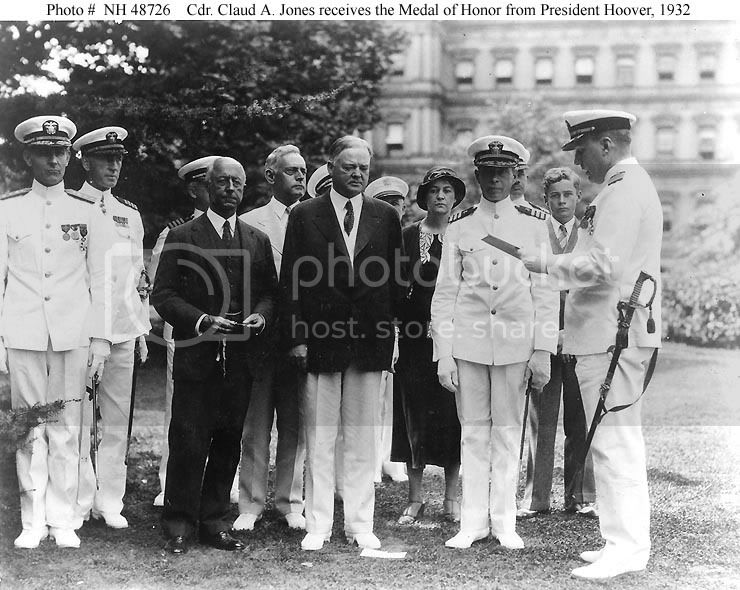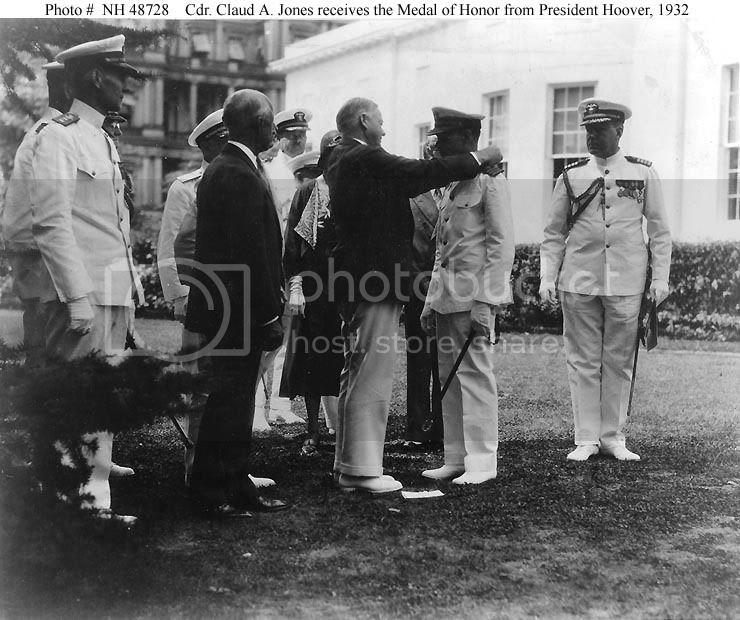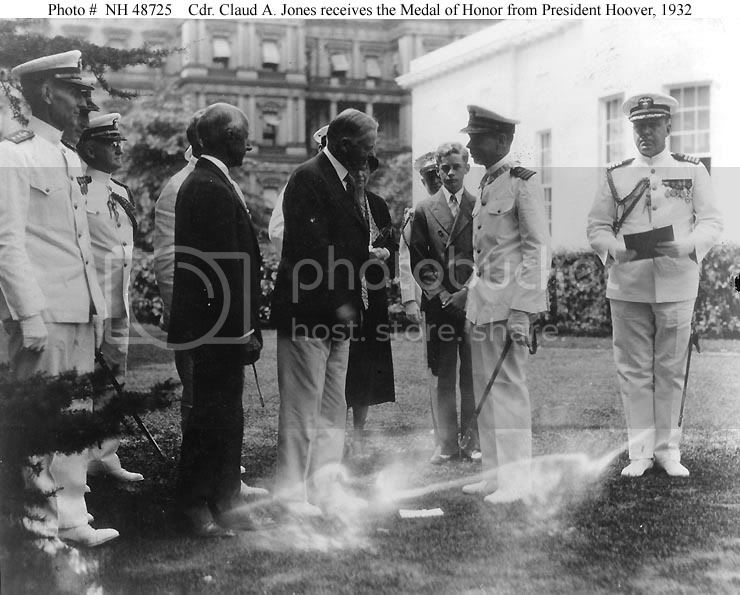Captain Claud A. Jones, USN
A portrait photograph, taken during the middle or later 1930s

Claud Ashton Jones was born on the 7th of October 1885 in Fire Creek, West Virginia. He was appointed to the U.S. Naval Academy from that state in 1903 and graduated with the Class of 1906. He served in the battleships Indiana and New Jersey during the next three years and received his commission as an Ensign in 1908. Between 1909 and 1915, Jones was assigned to the training ship Severn and the armored cruiser North Carolina, received post-graduate engineering education at the Naval Academy and Harvard University, and served in the battleships Ohio, New York and North Dakota. He was promoted to Lieutenant (Junior Grade) in 1911 and Lieutenant in 1914.
Late in 1915 Lieutenant Jones reported for duty as Engineer Officer of the armored cruiser USS Tennessee (renamed Memphis in May 1916). He was severely injured when she was wrecked by a tsunami on the 29th of August 1916. Many years later, in recognition of his heroic conduct in rescuing crewmen from the dying ship's steam-filled engineering spaces, then-Commander Jones was awarded the Medal of Honor. After recovering from his ordeal, he served ashore in industrial positions until after the end of World War I.
Lieutenant Commander Jones was designated as a specialist engineering duty officer in 1918 and in 1920-1921, in the rank of Commander, was Engineer Officer of the new battleship USS Tennessee. During the 1920s and into the early 1930s he had two Navy Department tours with the Bureau of Engineering, served in Europe as an Assistant Naval Attache and was senior engineering officer with the Battle Fleet. He was promoted to Captain in 1933, while again on duty with the Bureau of Engineering, and was Assistant Chief of that Bureau in 1935-1936. Captain Jones had machinery and material inspection assignments for the rest of the decade, then returned to Washington, D.C., to serve as Head of the Shipbuilding Division of the Bureau of Ships.
As a Rear Admiral, he was the Bureau's Assistant Chief and, for much of World War II, Assistant Chief of Procurement and Material. He became Director of the Naval Experiment Station at Annapolis, Maryland, from September 1944 until nearly the end of 1945. Retired in June 1946, Rear Admiral Claud A. Jones died at Charleston, West Virginia, on the 8th of August 1948.
The escort ship Claud Jones (DE-1033), of 1959-1974, was named in honor of Rear Admiral Jones.
This is Medal of Honor citation of Commander Claud A. Jones (as printed in the official publication "Medal of Honor, 1861-1949, The Navy", pages 106 & 107):
"For extraordinary heroism in the line of his profession as a senior engineer officer on board the U.S.S. Memphis, at a time when the vessel was suffering total destruction from a hurricane {sic} while anchored off Santo Domingo City, 29 August 1916. Lieutenant Jones did everything possible to get the engines and boilers ready, and if the elements that burst upon the vessel had delayed for a few minutes, the engines would have saved the vessel. With boilers and steam pipes bursting about him in clouds of scalding steam, with thousands of tons of water coming down upon him and in almost total darkness, Lieutenant Jones nobly remained at his post as long as the engines would turn over, exhibiting the most supreme unselfish heroism which inspired the officers and men who were with him. When the boilers exploded, Lieutenant Jones, accompanied by two of his shipmates, rushed into the firerooms and drove the men there out, dragging some, carrying others to the engineroom, where there was air to be breathed instead of steam. Lieutenant Jones' action on this occasion was above and beyond the call of duty."
This is a picture of Commander Claud A. Jones, USN receiving the Medal of Honor in ceremonies at the White House, 1 August 1932.
President Herbert Hoover is standing beside Cdr. Jones, and his wife and son are behind him.
Captain Walter N. Vernou, Presidential Naval Aide, is at right, reading the award citation.
Others present, are (from left to left center): Rear Admiral Samuel M. Robinson, Chief of the Bureau of Engineering; Captain Harold G. Bowen, Assistant Chief of the Bureau of Engineering; Secretary of the Navy Charles Francis Adams, with Captain Harold Stark, Aide to the Secretary, partially visible behind him; and Assistant Secretary of the Navy Ernest Lee Jahncke.
Commander Jones received the Medal for heroism on board USS Memphis (Armored Cruiser # 10) when she was wrecked on 29 August 1916.

Commander Claud A. Jones, USN receives the Medal of Honor from President Herbert Hoover, in ceremonies at the White House, 1 August 1932.
Cdr. Jones' wife and son are partially visible behind him and the President.
Captain Walter N. Vernou, Presidential Naval Aide, is at right.
In the left center is Secretary of the Navy Charles Francis Adams. At the extreme left are Rear Admiral Samuel M. Robinson, Chief of the Bureau of Engineering; Captain Harold G. Bowen, Assistant Chief of the Bureau of Engineering (partially visible); and Captain Harold Stark, Aide to the Secretary of the Navy (partially visible).

This is a photograph of Commander Claud A. Jones, USN talking with President Herbert Hoover, after being presented with the Medal of Honor in ceremonies at the White House, 1 August 1932.
Commander Jones' wife and son are standing in the center background. Captain Walter N. Vernou, Presidential Naval Aide, is at right, holding the award citation. Secretary of the Navy Charles Francis Adams is in the left center, with Assistant Secretary of the Navy Ernest Lee Jahncke partially visible behind him. Captain Harold Stark, Aide to the Secretary, is further to the left. At the extreme left are Rear Admiral Samuel M. Robinson, Chief of the Bureau of Engineering, and (partially visible) Captain Harold G. Bowen, Assistant Chief of the Bureau of Engineering.

Regards
Sean









